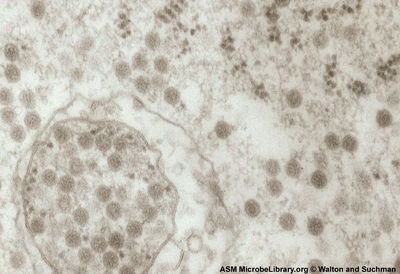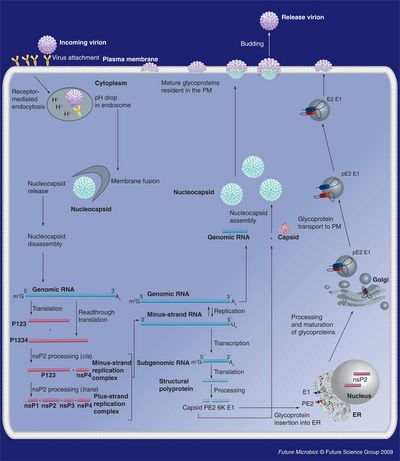Venezuelan equine encephalitis virus
Venezuelan equine encephalitis virus (VEEV)
A Viral Biorealm page on the family Venezuelan equine encephalitis virus

Baltimore Classification
Group IV: (+) sense single-stranded RNA viruses
Higher Order Categories
Family: Togaviridae
Genus: Alphavirus
Complex: New World
Description and Significance
Venezuelan equine encephalitis virus (VEEV) is an important animal and human pathogen found only in the Americas (the New World). VEEV is actually a complex of 7 different species that also include multiple subtypes and varieties [4]. Depending on the subtype, VEEV maintains either an enzoonotic or epizootic life cycle. Enzoonotic species sustain a chain of transmission between a rodent reservoir and mosquito vector. Epizootic species cause epidemics in horses and other animals of agricultural importance. during epidemics VEEV is spread by different species of mosquito vector. Most human cases of VEEV result from spill-over into the human population from an epizoonotic outbreak. Human are only incidental and usually dead-end hosts.
In the 1960's VEEV was weaponized by the U.S. and the U.S.S.R.[5]. The virus is considered a category B select bioterrorism threat by the U.S. government because it causes only moderate morbidity and low mortality rates in humans.
The virus has a biosafety level rating of 3 (BSL 3) which means that it can only be worked with inside of specially equipped laboratories designed to deal with BSL 3 agents [6]. although VEEV is transmitted by mosquitoes in nature it is a very good aerosol. The virus has been implicated in more than 150 cases of accidental laboratory exposure that were not associated with cuts or needle pricks [7].
VEEV is an arbovirus (arthropod-virus), a general term used to describe viruses that are transmitted via hematophagous arthropod vectors such as mosquitoes, flies and ticks. To be considered a true arbovirus there must be replication of the virus within the vector and VEEV is no exception [8].
Within the classification of arboviruses there is the genus alphavirus that includes VEEV. Alphaviruses cause arthritic and encephalitic disease in mammals. This group includes the pathogens O'nyong'nyong virus, Chikungunya virus, Western equine encephalitis virus, and Eastern equine encephalitis virus. Alphaviruses are not just important human and animal pathogens but have also been used as a model system in the study of enveloped virus structure and as viral vectors in gene therapy research [9][10].
Genome Structure

VEEV has a non-segmented 11.4 kb (+) sense ssRNA genome with a poly (A) tail. The genome contains two reading frames that encode for two different polyproteins. Two-thirds of the genome starting from the 5’ end encode for a polyprotein that contains the four nonstructural proteins nsP1, nsP2, nsP3, and nsP4 (viral RNA-dependent RNA polymerase) that are required for genome replication. The last 4 kb of the genome encodes for a polyprotein with the capsid and envelope proteins CP, pE2, 6K, and E1 [11].
The viral RNA itself contains four conserved sequence elements (CSEs) which interact with various viral and host proteins that are involved with the replication, transcription, and packaging of viral RNA. A small non-translated region at the beginning of the 5’ end of the genome (CSE1) appears to fold up into a stem-loop structure that acts as a promoter for (+) RNA strand replication from a (-) RNA template. CSE2 is found near the 5’ end as well but it is within the coding region for nsP1 and may be a promoter for the synthesis of (-) strand template RNA from genomic (+) strand RNA. CSE4, located just upstream of the poly (A) tail on the 3’ end of the RNA appears to be involved in promoting the synthesis of template RNA as well. CSE3 is located between the ORFs and is required for transcription of subgenomic RNA (smaller sections of mRNA that encode for only part of the genome). Just upstream Near CSE4 there are also repeated sequence elements 40-60-nt in length that bind to host proteins involved in the translation of viral RNA [12].
Virion Structure of Venezuelan equine encephalitis virus
Venezuelan equine encephalitis virus has an enveloped isohedral nucleocapsid. The capsid has a triangulation of t=4. Virions appear round and are 65-70 nm in diameter. The envelope surrounding the nucleocapsid (NC) is derived from host lipid bilayer embedded with approximately 240 copies of E1 and E2 glycoproteins. The glycoproteins form heterodimer spikes that link up in an isohedral lattice that also displays t=4 symmetry like the NC [13].
Reproductive Cycle of Venezuelan equine encephalitis virus in a Host Cell

VEEV virions attach to a host receptor via the glycosylated envelope protein E2 and possibly E1. The exact host receptor for VEEV is unknown but it is probably fairly common because the virus can infect vertebrate (mammals) as well as invertebrate (mosquitoes) cells. One hypothesis is that single amino acid substitutions in the E2 protein allow the virus to attach to multiple cell surface receptors.
Once attached to the receptor the virus is endocytosed and the pH of the endosome drops and causes the E1-E2 dimer to destabilize and then trimerize with the late endosomal membrane. This trimerization allows for the fusion of the viral envelope with the endosome membrane and the eventual escape of the nucleocapsid into the cytoplasm. The exact mechanism of nucleocapsid uncoating in the cytoplasm is not known but may be related to some sort of destabilization by the initial drop in pH in the endosome.
(+) Genomic RNA is translated using host ribosomes and the nonstructural polyprotein is processed and the resulting proteins form replication complexes within vacuoles derived from lysosomal and endosomal membranes and begin synthesis of (-) template RNA. From the (-) template strand both genomic RNA and subgenomic RNA are transcribed. The subgenomic RNA only encodes for the structural polyprotein that contains envelope and capsid components. The capsid subunit CP autoproteolyses and self assembles into nucleocapsids in the cytoplasm and genomic RNA is encapsidated by an unknown mechanism.
The remaining segment of polyprotein translocates into the ER. E1 and pE2 are folded and glycosylated in the ER and then take to the golgi where pE2 is cleaved to form E2 and E3. E3 seems to be involved with the dimerization between E1 and E2 but its exact role in viral replication has yet to be elucidated(review). From the golgi the E1-E2 heterodimer is transported to the plasma membrane where E2 is required for nucleocapsid fusion with the plasma membrane and eventual viral budding.
During infection VEEV turns off cellular transcription and translation during infection which leads to a decreased response from the innate immune system. Infection also initates apoptosis of the cell by some unknown mechanism (review).
Viral Ecology & Pathology
In nature VEEV is only transmitted by mosquitoes but aerosol transmission has been observed in the lab. Mosquitoes become infected after feeding on infected blood. The virus eventually escapes the gut of the insect where it makes its way to the salivary glands where it replicates. The new host is infected when virus laden saliva is injected into the skin while the mosquito is feeding.(presentfuturearbothreats)
VEEV can either sustain an enzootic or epizootic life cycle. Enzootic subtypes have a smaller host range than epizootic strains and are transmitted between resovior hosts such as rodents by mosquitoes of the genus Culex . These subtypes (II-IV) rarely cause disease unless a susceptible human or horse ends up in the middle of the transmission cycle. In order for an enzootic strain to start an epizootic There must be changes in genotype as well as geographic cross-over between susceptible animals and mosquito vectors. This means that either there has to be a dramatic change in mosquitoe habitat such as an unusually wet season that allows the insects to move beyond their normal geographic range. Or horses or humans need to be moved near swamps and forests (this often times occurs when land is cleared for agricultural use).
The epizootic subtypes of VEEV are IAC and IC. These subtypes are responsible for most major human and equine (horse) epidemics. Epizootic subtypes arise from changes in amino acid sequence of the E2 envelop protein. Even single amino acid substitutions can result in epizootic strains. E2 protein is responsible for binding to host receptors so it makes sense that changes in the structure of this protein affect host range which in turn allows for zoonotic outbreaks (epidemics in animals) that can incidentally involve humans. (transmission) Changes in E2 structure allow mosquitoes of the genera Ochlerotatus and Psorphora to transmit the disease to horses and few other mammals that display high titres of virus in their blood. A high number of viruses in the animals blood is called viremia and is important in maintaining an epidemic. Luckly for the animals that survive infection (mortality is high) they usually produce strong enough antibodies to prevent reinfection.
VEEV in humans presents mostly as a flu-like illness and it often times missed because of a lack of surevailliance and laboratory diagnosis. Disease mortality is less than 1% and (encephalitic) only 14% of cases involve the central nervous system. In fatal human cases there is edema, congestion, hemorrages, meningitis, and encephalitis of the brain and spinal cord. The lungs, liver and lymphoid tissue are also ravaged by the virus.
In horses epizootic VEEV has very high mortality (50-90%). It causes swelling of the brain (encephalitis) that often-times results in fatal seizures.
http://www.microbelibrary.org/Virus/details.asp?id=2408&Lang=
Vaccines and Treatments
Currently treatment of VEEV infection is mostly supportive because there are no specific drugs for alphaviruses but there is a vaccine for both humans and horse. The live attenuated vaccine known as TC-83 is a strain of VEEV that was passed 83 times in guinea pig heart cells (vaccine). There is also an inactivated form of the vaccine known as C-84 derived from the TC-83 strain. Currently only the C-84 vaccine is liscensed for us in horses in the U.S. although countries such as Mexico and Colombia still produce the live vaccine for horses. In the U.S. only at risk military and laboratory personal are vaccinated with the TC-83 strain and some recieve C-84 boosters if the intial vaccination did not produce sufficient immunity. The vaccine does have side affects that ranged from mild to moderate and did not provided full protection of nonhuman primates challenged by aersol exposure the route of transmission most likely if VEEV were to be used in a biological terrorist attack
References
[1] Jose, J., J.E. Snyder, R.J. Kuhn. “A structural and functional perspective of alphavirus replication and assembly.” Future Microbiology 4 (2009): 837-856
[2] Berenyi, O., T. Bakonyi, I. Derakhshifar, H. Koglberger, N. Nowotny. “Occurrence of Six Honeybee Viruses in Diseased Australian Apiaries.” Applied and Environmental Microbiology 72.4 (2006): 2412-2420.
[3] Boyapalle, S., N. Pal, W.A. Miller, B.C. Bonning. “A glassy-winged sharpshooter cell line supports replication of Rhopalosiphum padi virus (Dicistroviridae). Journal of Invertebrate Pathology 94 (2007): 130-139.
[4] Chen, Y.P., J.S. Pettis, A. Collins, M.F. Feldaufer. “Prevalence and Transmission of Honeybee Viruses.” Applied and Environmental Microbiology 72.1 (2006): 606-611.
[5] “Cripavirus.” ICTVdB Descriptions <www.ncbi.nlm.nih.gov/ICTVdb/ICTVdB/00.101.0.01.htm>
[6] de Miranda, J.R., M. Drebot, S. Tyler, M. Shen, C.E. Cameron, D.B. Stoltz, S.M. Camazine. “Complete nucleotide sequence of Kashmir bee virus and comparison with acute bee paralysis.” Journal of General Virology 85 (2004): 2263-2270.
[7] “Kashmir bee virus.” NCBI Taxonomy browser <www.ncbi.nlm.nih.gov/Taxonomy/Browser>
[8] Oldroyd, Benjamin P. “Unsolved Mystery: What’s Killing American Honey Bees?” PLoS Biology 5.6 (2007).
[9] Shen, M., L. Cui, N. Ostiguy, D. Cox-Foster. “Intricate transmission routes and interactions between picorna-like viruses (Kashmir bee virus and sacbrood virus) with the honeybee host and the parasitic varroa mite.” Journal of General Virology 86 (2005): 2281-2289.
[10] Slonczewski, J.L., J.W. Foster. “Chapter 6: Virus Structure and Function.” Microbiology: An Evolving Science (2009): 181-217.
Page authored for BIOL 375 Virology, September 2008
